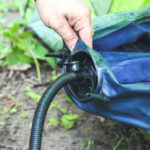There are very few things more relaxing when you are enjoying a vacation than relaxing in your hammock.
These things are absolutely perfect for camping during the summer when it’s very hot as they are very breezy, so it’s definitely worth trying to get your forty winks in a hammock.

Of course, hammocks can let a lot of cold air in, and as a result it can get a little bit nippy when it gets colder outside. Getting a sleeping pad for your hammock is thus a fantastic way to warm yourself up a little during those chillier evenings.
But how do you find the best sleeping pad for your hammock/ We’re here to answer that question. Read on for our top picks, in addition to a handy buyer’s guide to help you to narrow down your decision.
OUR TOP PICK
Table of Contents
Big Agnes Q Core SLX Ultralight Sleeping Pad
If you want a great sleeping pad for your hammock when you’re out exploring the world - or even if you just want a nap in the garden - look no further than getting the Big Agnes Q Core SLX Ultralight Sleeping Pad.
This sleeping pad is ideal no matter where you want to sleep, and thanks to the high insulation you can keep nice and warm throughout the whole day and night.
There are a lot of things to love about this sleeping pad. For starters, it has been constructed out of lightweight materials and you can also inflate it.
Thanks to this, it also doesn’t take up a whole lot of space in your bag despite the ‘big’ in the name. You can stuff it into your backpack without much trouble, and you’ll still have space for more. It’s even very thick, providing you with extra comfort.
If you are at all concerned, you will be pleased to know that the product comes with a warranty, so if there are any issues you can send it back without any trouble.
It’s a fantastic choice if you tend to toss and turn, or slide around. The only real issue is that it’s a little expensive, but it’s certainly worth the extra cost.
Pros
- Warranty
- Lightweight
- Comfortable
Cons
- Expensive
EDITORS CHOICE
Some sleeping pads are great, but do you know what’s even better? A sleeping pad made specifically for hammocks.
The Klymit Hammock V Sleeping Pad is made for your hammock, meaning it fits perfectly so you can sleep easy and comfortably.
If you had ever wanted to imagine yourself as a caterpillar turning into a butterfly, then this is your chance. When you jump into your hammock with this sleeping pad inside, you will be nestled up in a cosy little coccoon. It will keep you toasty warm all through the night, even through those particularly cold summer nights.
The sleeping pad features nonslip technology so you don’t need to worry about sliding around everywhere, and packing it into your backpack is no problem at all.
It weighs fairly little thanks to the fact that it’s inflatable. Despite its inflatability, it’s also very durable and it’s pretty hard to puncture it.
Perhaps the only issue that we could find is that it’s pretty pricy, but this is inevitable considering it’s been designed especially for hammocks.
Pros
- Durable
- Easy to set up
- Made specifically for hammocks
Cons
- Very expensive
BEST VALUE
If you’re going to be using your hammock sleeping pad a lot, it’s essential that you get a durable option that will stick with you through even the toughest of times.
The Fox Outfitters Ultralight Series Self Inflating Camp Pad is a great choice for this. As the name suggests, it’s self inflating so setting it up is a breeze.
Not only that, but the pad is very lightweight which makes it great for traveling on foot. The pad features a foam core that’s very durable, yet comfortable enough to mean that you will get a restful night’s sleep. It’s ideal for pretty much any environment and it’s sure to keep you nice and warm even when it’s cold.
In addition to this, the pad features a diamond foam pattern, which essentially means that your body weight is well distributed across the pad when you sleep on it, so you don’t need to be concerned about waking up with aches and pains in the morning.
It’s even very affordable. It isn’t without its issues though. Despite the fact that the pad is lightweight, it is also incredibly bulky. As a result, packing it can be a bit of a hassle.
Pros
- Durable
- Affordable
- Self inflating
Cons
- Bulky
RUNNER UP
The next choice on our list is the ALPS Mountaineering Foam Camping Mat. This mat is ideal if you’re camping in a hammock, but it’s also versatile enough to be used for a range of other things too.
It’s a great choice for backpacking, thanks to the lightweight construction and the nifty carrying straps.
When you’re sleeping, the mat will stay firmly in the bottom of your hammock without sliding around everywhere thanks to the closed cell texture.
This makes it extra comfortable to relax in, and its uber soft too! If it happens to be affected by rain or water somehow you will also be pleased to know that the mat can dry in no time at all.
If all of this wasn’t already enough to convince you, you will be pleased to know that this pad is available at a very low price. It’s a bargain for such a high quality product.
The only real problem is that it isn’t totally water resistant. This shouldn’t be a huge problem though so long as you bring a groundsheet with you if you plan on sleeping on the ground.
Pros
- Easy to use
- Portable
- Affordable
Cons
- Not totally water resistant
RUNNER UP
The Outdoorsman Labs Camping Sleeping Pad is yet another fantastic option for anyone looking to enjoy camping in a hammock. This pad is incredibly lightweight so it’s easy to carry around - it only weighs 16 ounces in total!
The pad is perfect for numerous reasons. For starters, you can expect this sleeping pad to stand the test of time thanks to how durable it is.
That’s not all either - the comfort is truly unparalleled. This is thanks to the air cells in the pad that will contour to the shape of your body. It’s almost like memory foam, but for hammock sleeping pads.
In addition to this, you won’t need to break the bank in order to buy this sleeping pad. It’s ideal if you’re on a budget.
Of course, it isn’t awfully thick, so if you prefer to sleep on a thicker surface then it may be best to look elsewhere. If you’re fine with a thinner surface, then this will be a great choice for you.
Pros
- Durable
- Conforms to the shape of your body
- Affordable
- Lightweight
Cons
- Not very thick
Best Sleeping Pad for Hammock Buying Guide
Why Should I Use a Hammock Sleeping Pad?
Hammocks are pretty cool as they allow you to rest off the ground, in contrast with a tent. This is partially why they’re so breezy - the air can circulate completely around your body.
Now, this is great for hot nights, but it is pretty inconvenient when it’s cold.
At least with a tent you have the heat from the ground to warm you up a little. This is not the case with a hammock, which can make your rear end feeling a little cold!
A hammock sleeping pad is pretty much the answer to your prayers in this situation. They essentially give you an extra layer on the bottom of the hammock, so it’s a little harder for the cold air to get to you.
As a result you can be a little bit warmer during the night. You can even use sleeping pads for pretty much any time of the year - it doesn’t have to be cold.
How To Choose the Best Sleeping Pad for Your Hammock
Now that you know why hammock sleeping pads are so important, it’s time to dive into how to buy the best one for you. After all, it’s essential that you can buy a hammock sleeping pad that will fit with your particular needs.
There are a lot of things to consider, and what may be good for one person may not necessarily be great for another person. With that being said, here are just a few of the main things that you should take into consideration.
Weight of the Pad
The biggest issue with sleeping pads is that they can sometimes be incredibly heavy. This means that they will take up a lot of space in your bad, something that may not be ideal if you are going to be doing something like hiking and you don’t have an easier way to transport your gear from one place to another.
If you’re going hiking or backpacking then it’s worth considering getting a more lightweight sleeping pad, and one that will be small enough to give you enough space in your bag for other items.
This may not be a concern for you if you’re just doing some standard hammock camping. In this case you should think about the comfort of the pad above anything else.
Size When Packed
Again, this is another consideration if you have limited amounts of space. For instance, if you are hiking with a smaller backpack then it goes without saying that getting a hammock pad that you can store and roll easily.
An inflatable sleeping pad can be handy, or alternatively you can sometimes strap the pad onto the exterior of your bag - you will have to check if the manufacturer has said that this is possible.
You can’t do this with an air pad though, as it may get pierced while you are walking.
Shell Material
There are two main kinds of sleeping pads for hammocks - air pads and foam pads. It will cost you a lot less money to get a foam pad, but unfortunately these options are a lot more bulky. They also don’t have the same longevity as air pads do.
You will usually feel more comfortable with an air pad but the issue is that it can get damaged easily when you are on the move, especially if you’re doing something like backpacking.
It’s worth noting that there are some pads that will come with certain materials or textures. These are usually in place to ensure that the pad doesn’t slip around underneath you when you’re trying to sleep - not very comfortable, to say the least! It’s worth considering this if slipping around like a fish isn’t quite your vibe.
Warmth
Part of the reason why you need to buy a sleeping pad in the first place is to keep you warm. What’s the point in buying a sleeping pad that doesn’t provide you with any warmth?
This is where you need to think about the material, as some materials can also insulate and reflect the temperature of your body. This is vital for heat retention. When seeking out your sleeping pad for your hammock, check for the R Value on the manufacturer’s guidelines.
If you have a higher R value then it means that it’s easier for the pad to insulate. If you look online you can often find guidelines about the sort of R value that you are going to need. There are some pads that aren’t suitable for most months other than summer, whereas others can be used for colder seasons such as the fall and the spring.
Pad Length and Width
The size of sleeping pad that you get is largely going to depend on the way that you sleep. For instance, if you like to sleep on your side then getting a normal sized pad should be completely fine.
If you sleep on your back though you may need a slightly wider sleeping pad.
Not only this, but you should also consider the pad size based on your height. You’ll need a larger pad if you’re taller, and you need to make sure that the pad supports your hips and shoulders well.
Shape
Sleeping pads can come in all sorts of different shapes. For instance, you could get a mummy shaped pad that cuts away the edges that you may not use.
These are great for saving space, but perhaps you would feel more comfortable using a larger pad so you have a little more room.
A four sided pad may be better for you if you tend to sleep on your back. In short, you need to consider the shape of the pad and if it aligns with your wants and needs.
Cost
You should always think about the cost of a sleeping pad for your hammock before you buy - setting a budget is important, but you also want to get something strong that will last.
Don’t go and get the cheapest pad just to save a little money - getting a good night’s sleep is priceless and it’s definitely worth a couple of extra dollars.
Use
A sleeping pad that’s designed for something like camping could be heavier without many repurcussions - you can put it in your car and you wouldn’t need to worry about carrying it around with you.
If on the other hand you are planning on going backpacking or hiking, you are going to need to think about the weight of the pad.
After all, something too heavy may be cumbersome and you’ll feel exhausted when you are walking. Sometimes it’s worth being like Goldilocks - look for something that’s just right.
You may find something relatively lightweight that you will still find incredibly comfortable. Alternatively you can buy a few different kinds of sleeping pads that you can use for different situations.
Thickness
The thickness of your sleeping pad for your hammock can have a huge impact on how warm and comfortable you are going to be while you sleep on it.
You don’t want to have an exceptionally thick pad as you may not feel properly supported in the hammock. It’s also going to be heavier if it is thicker. You need to find a level of thickness that works well for you.
Frequently Asked Questions
What is the difference between a hammock sleeping pad and an underquilt?
Both of these items are made in order to keep you warm while you sleep in a hammock. With that being said, they are two very different things. An underquilt will cover the whole hammocks, and they are designed to retain heat.
A sleeping pad is slightly smaller and so it doesn’t cover the same amount of space. This may sound like a bad thing but this isn’t the case - this portability can make them very versatile.
In fact, you can use them not only on the bottom of your hammock but also for sleeping on the ground. Pretty neat, huh?
- Are Merrell Shoes Good? – An Unbiased Review of Merrell Footwear - December 9, 2023
- Where Are Merrell Shoes Made? - December 9, 2023
- Camping in 40-degree Weather: Tips and Tricks - September 25, 2023










![What Is A Self Inflating Sleeping Pad? [Must-Read] What Is A Self Inflating Sleeping Pad? [Must-Read]](https://grandcircletrails.com/wp-content/uploads/2022/03/What-Is-A-Self-Inflating-Sleeping-Pad-1-150x150.jpg)

![Yoga Mat as Sleeping Pad? [Pros and Cons Included] Yoga Mat as Sleeping Pad? [Pros and Cons Included]](https://grandcircletrails.com/wp-content/uploads/2022/05/Yoga-Mat-as-Sleeping-Pad-150x150.jpg)

![How to Protect Yourself While Camping? [TOP Camping Safety Tips] How to Protect Yourself While Camping? [TOP Camping Safety Tips]](https://grandcircletrails.com/wp-content/uploads/2022/07/How-to-Protect-Yourself-While-Camping-1-150x150.jpg)